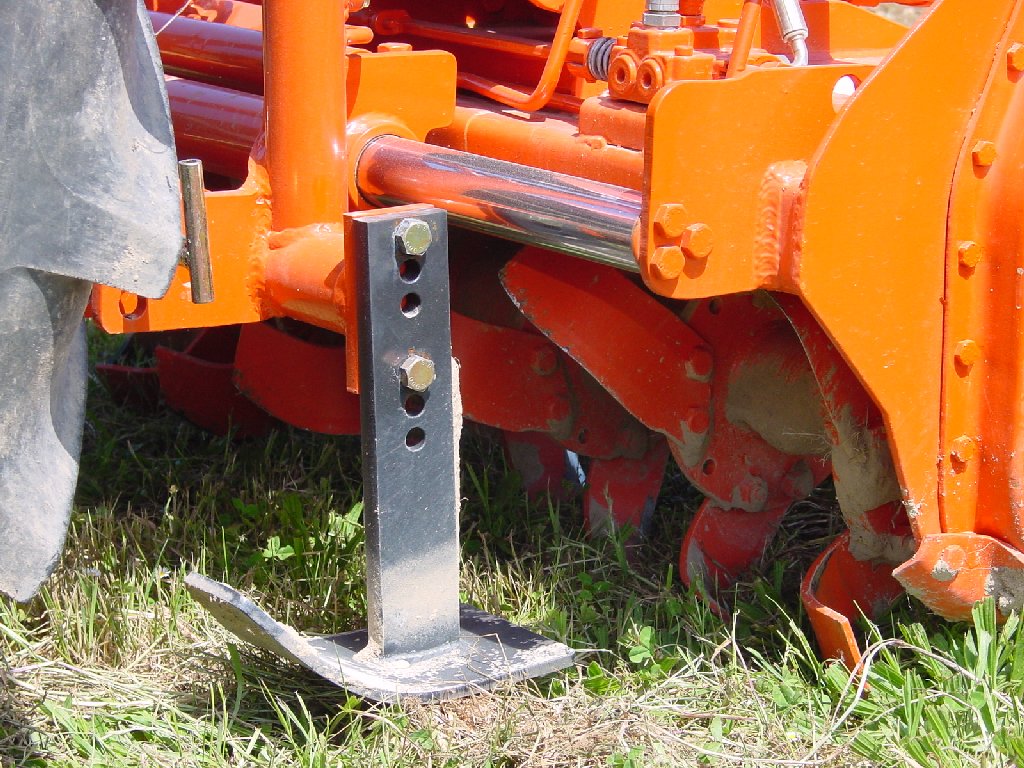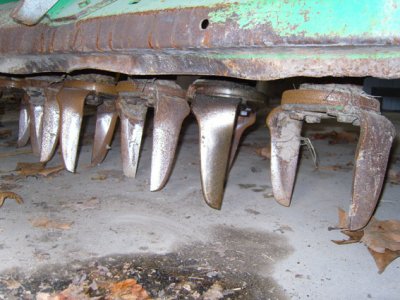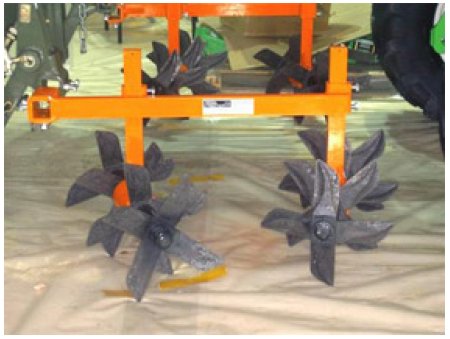Rotary tool
The aim of inter-row powered tools is to eliminate weeds under the row by mechanical action. Tools with a vertical axis of rotation have a chassis, angle gearboxes, rotors and steel teeth. Horizontal axis tools, such as the rotavator and roto-spade, use a horizontal rotor fitted with teeth or spades to cut and project the soil. The rotary hoe, with a frame and stars fitted with curved blades, pulls up weeds and lightly throws the soil backwards, enabling fast, efficient work.

Work objective
The aim of this type of equipment is to destroy weeds present under the row by mechanical action. The aim is to extract the plant from the soil rather than break it up.Components of inter-row powered tools
manufacturers offer a wide range of tine, spade and rotary variants.Tools with a vertical axis of rotation
The chassis
The chassis consists of a sealed box containing a set of gears. For combined work, some models have a reinforced chassis with a three-point linkage.The angular gearbox
The angular gearbox transmits the power supplied by the tractor's PTO to the rotors. The angular gearbox transforms the rotation from a horizontal to a vertical plane.The rotors
The rotors are made up of tines placed in pairs on rotors distributed across the width of the tool, at a rate of 3 to 5 per metre. Each rotor rotates in the opposite direction to its neighbour, with an angular offset of 90°. The rotors rotate at a frequency of between 200 and 450 revolutions per minute.The teeth
The teeth are generally made of steel and bolted to the rotor. Maschio offers 2 systems, the first QUICK FIT allows the teeth to be removed quickly and QUICK PLUS prevents stones from getting stuck between the rotor and the casing.Tools with horizontal axis of rotation
This category is the oldest and most widespread. The driven inter-row tool consists of a horizontal rotor of variable width and diameter. The rotor consists of a tube, to which several flanges are welded, which carry the spades. Made up of tines of varying shapes depending on the manufacturer, they are bolted onto the flanges. They are generally mounted in groups of 4 or 6 on flanges spaced 25 cm apart (i.e. around 16 to 24 blades per metre). The rotor rotates at a speed generally between 140 and 200 revolutions per minute and rotates in the direction of travel of the tractor.Adjustment and use of inter-row power tools
Horizontal axis: the horizontal axis rotary cultivator (rotavator)

Setting
- Forward speed: the higher the speed, the coarser the clods.
- Rotor speed: the higher the speed (at a constant forward speed), the finer the work. A gearbox, often with interchangeable pinions, is used to modify this fineness.
- Working depth: this is determined by the position of the skids, or on larger machines by the depth wheels. The working depth will be equal to the distance separating the lower part of the rotor from the shoe.
- The position of the deck: when the deck is raised, the soil is thrown backwards without encountering any obstacles, with the heavier particles going further than the lighter ones. As a result, the majority of clods are found on the surface. When the apron is lowered, the clods thrown backwards hit it and break up behind the machine, leaving fine soil on the surface.

Use
The tool cuts up the soil and then throws it backwards. An adjustable tilting carriage at the rear of the machine helps to break up the clods thrown backwards. Power consumption is around 30 horsepower per metre of working width. In wet clay soils, there is a significant risk of sole formation.Horizontal axis: the spading machine or roto-spade
Adjustment (similar to the Rotavator cultivator)
- Forward speed: the higher the speed, the coarser the clods.
- Rotor speed: the higher the speed (at constant forward speed), the finer the work. A gearbox, often with interchangeable pinions, is used to modify this fineness.
- Working depth: this is determined by the position of the skids, or on larger machines by the depth wheels. The working depth is equal to the distance between the bottom of the rotor and the skid. A comb behind the spades helps to break up clods.
Use
This machine was first developed for market gardening and has good penetration capacity in compacted soils.The working part of the machine consists of a series of spades, the number of which varies according to the working width. The spades are driven by a crankshaft attached to the end of a lever, and connected to the chassis by a joint located roughly in the middle of the same lever. The work performed is very similar to manual spading. The working depth can be as much as 30 centimetres, while the power required is in the region of 25 to 30 horsepower per metre of working width. The roto-spade has the advantage of not forming a plough bed.
Vertical axis: the rotary harrow

Setting
- Forward speed: the higher the speed, the coarser the work.
- Rotor speed: the higher the speed (at a constant forward speed), the finer the work.
- Working depth: this is determined by the position of the rear roller. It is fitted with a stop system that allows the harrow to rest on it to limit the working depth.

Use
The harrow is designed to prepare the seedbed or level ploughed fields. This is achieved by rotating the tines, which move the soil towards the front of the tool.The rotary hoe
Work objective
Rotary hoes work the soil by pulling up weeds with a slight rearward projection. They do not have the disadvantages of claws (problems of blockages) and do not produce a plough sole.This tool is designed exclusively for shallow soil cultivation. It pulls up the weeds with a slight rearward projection. It's a bit like using a hoe (I plant, I pull). It allows a high work rate because it requires a fairly fast forward speed (8 to 10 km/h).

Components of the rotary hoe
- The frame: made of welded steel, it provides the link between the trees and the tractor. It must be sufficiently rigid and heavy to ensure good penetration of the blades into the soil.
- The stars: each shaft is made up of several stars to which working parts are attached at 90°. The working parts are shaped like curved blades. The blades are generally bolted to the star to allow quick removal and facilitate maintenance.
Adjusting and using the rotary hoe
Adjustment is simple, as the working depth can be increased in two ways:- by opening the angle of the shafts (note that some manufacturers offer fixed frames)
- by adding weight to the tool
This type of tool allows the soil to be levelled out after clawing, for example.
